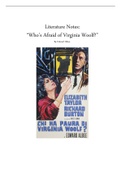Samenvatting
Summary Analysis: Who's Afraid of Virginia Woolf?
An act by act analysis of WAVW by Edward Albee -- The analyses for each act are broken down into specific characters and themes, as well as recurring ideas that apply to each of the characters (i.e. George's impotence, Honey's childishness). Close reading of specific quotes and how they apply to th...
[Meer zien]





